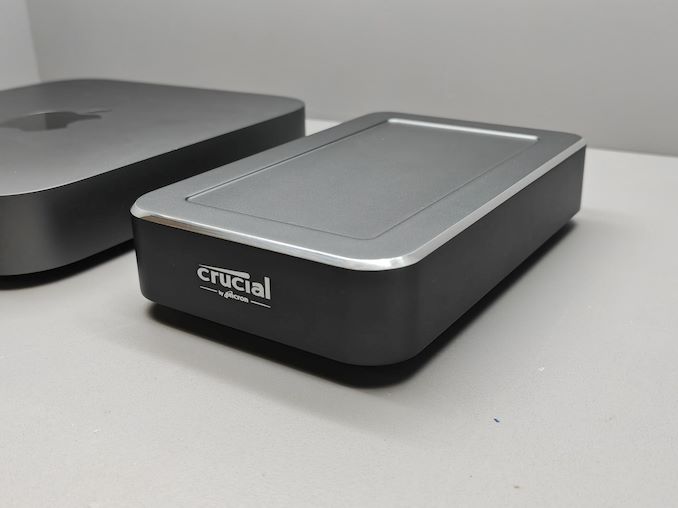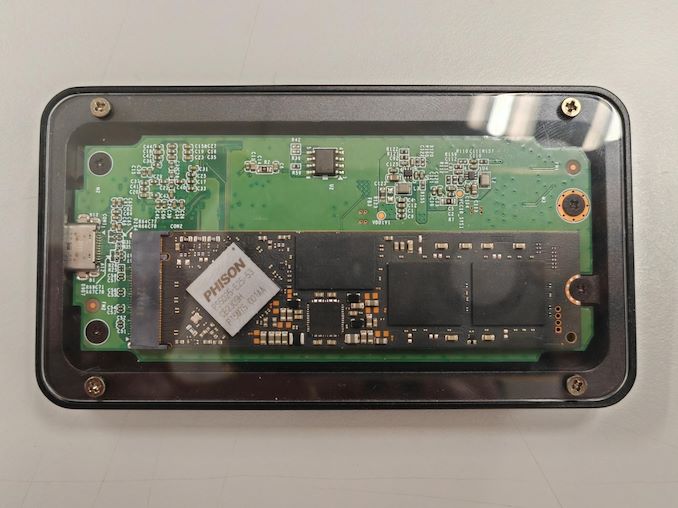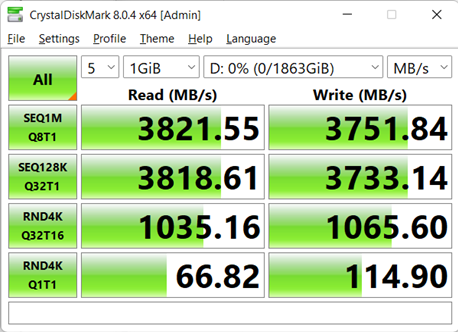Micron at CES 2024: USB4 SSD Technology Demonstrations
by Ganesh T S on January 11, 2024 8:00 AM EST
Micron's consumer brand, Crucial Memory, has been putting extra focus on the SSD market over the last few quarters. The brand was marketing entry-level QLC drives in the 2018 - 2022 time frame. Recently, emphasis has also been placed on cutting-edge SSDs - both internal (such as the Gen4 T500 and Gen5 T700) and external (such as the X10 Pro). Vertical integration, coupled with Micron being the first flash manufacturer to achieve volume production of 200+ layer 3D NAND, has been crucial to Crucial's success in these segments.
At the 2024 CES, Micron had a couple of interesting USB4 SSD technology demonstrations for its resellers / partners and invited media. These are essentially products under development (with no guarantees that they would make it to the market in their current form). Both products are bridge-based solutions using the ASMedia ASM2464PD USB4 to NVMe accessory controller. The key update over the popular ASM2364 (USB 3.2 Gen 2x2 upstream, and PCIe 3.0 x4 downstream) is the shift to a 40 Gbps USB4 upstream port along with a PCIe 4.0 x4 link downstream. The power delivery component of the Type-C specification is also implemented within the controller.
The portable SSD version has a gumstick form-factor, with the transparent casing housing a M.2 2280 SSD - a 2TB Gen4 Micron 3400 OEM drive in this case.
The drive is expected to be passively cooled, with the larger form-factor enabling a thermal performance similar to that of the X10 Pro / X9 Pro. Bridge-based solutions are the standard option for high-performance portable SSDs.
Similar configurations (bridge + DRAM-equipped M.2 SSD) such as the SanDisk Extreme PRO v2 (E81) have yielded excellent all-round performance for a wide range of workload types. We expect the same to continue in the USB4 era. That said, vendors like ADATA using the same bridge have opted for active cooling to avoid thermal throttling in their USB4 PSSD. It remains to be seen if this design will remain fanless in its final form (and if it does, thermal performance would be an interesting aspect to analyze).
The USB4 desktop SSD is a comparatively unique product. This is an actively cooled design with a small fan, and uses a U.3 SSD inside. Other vendors like OWC have tried multiple M.2 SSDs configured with software RAID in a large-sized enclosure, but this one has a single high-capacity drive (8TB in the sample being demonstrated).
Designed for stacking (without daisy-chaining support), the eSSD also requires external power. The drive can also power notebooks through the USB4 connection, which can make up for the presence of a discrete power adapter. Specifics of the power delivery will only be available when the product is officially introduced. This product could be made more attractive by having some downstream USB Type-A / Type-C ports (eSSD in a dock). That said, there are two aspects that will probably make this the performance and consistency king of USB4 SSDs - the presence of a fan, and the use of a Gen4 U.3 SSD (which is most likely an enterprise drive that advertises worst-case performance and not speeds in the SLC cache region).
The current crop of USB4 SSDs are focused on performance, and sacrifice power- and energy-efficiency. Those aspects will be addressed by native USB4 UFD controllers like Phison's U21. Silicon Motion tends to keep controllers under wraps until reference designs are ready to ship (if the introduction of the SM2320 was anything to go by). We expect external / portable SSD vendors to eventually add native UFD controller-based products to their USB4 lineup, but that seems unlikely to happen in the first half of 2024.

















12 Comments
View All Comments
Hulk - Thursday, January 11, 2024 - link
For me having an external power supply for a USB device is a non starter. The whole beauty of USB is it's portability. Also I care not about faster sequential speeds once they reach about 1 or 2GB/sec, honestly I don't move huge files around often enough for that metric to matter. The random access numbers are more important and these new gen drives don't do any better than last gen. Seem like there is always a near useless metric for manufacturers to use to push new products on us that won't really offer performance benefits in real world usage. For SSD's it's sequential data rates when what they really need to focus on is random rates. For CPU's it's MT performance, when they really need to focus on ST performance, etc...deil - Thursday, January 11, 2024 - link
I agree, it will definitely not replace a pendrive. A tiny thing you can put anywhere, and forget it to exist for months. Still this can be very useful as mac backup machine for example. Fast storage means it will not take 2hours to backup stuff regularly, and it's not taking a lot of space.it likely can exist as a filler between people who need a regular NAS, and those who use random usb's as backup devices.
FWhitTrampoline - Thursday, January 11, 2024 - link
Is this not powered over the USB Type-C power delivery part of the connector/port that is USB4(Includes the TB3) protocol standard. So maybe that's powered via the Type-C port(?).And see for the article here and this:
"The power delivery component of the Type-C specification is also implemented within the controller."
ganeshts - Thursday, January 11, 2024 - link
The 'PD' suffix of the ASMedia controller is for these two aspects:The device can advertise itself to a host PC as requiring 5V fixed, without the need for other chips. Also, initial Type-C designs had to use a separate board component to detect Type-C cable orientation. That is not required with this ASMedia controller.
The desktop SSD requires the ability to supply power back to the host. So, that does involve extra circuitry on the board.
ganeshts - Thursday, January 11, 2024 - link
Yes, YMMV.External HDDs (3.5") connecting over USB (regular DAS) are still quite popular, as both Seagate and WD are continuing to update those models with the top-capacity 20TB / 22TB drives. They require external power, but still sell well.
I think Micron / Crucial's desktop SSD can make a dent in that market - as we already have 30TB U.3 SSDs (it is pricey, but there may be users who need that type of 'portable' performance).
DanaGoyette - Thursday, January 11, 2024 - link
Why the heck would you put a gen4 M.2 drive under a *plastic* cover, to trap the heat? If that's just for the demo model, they should have a sticker or something saying: real product will have a heatsink here.Many of the USB M.2 enclosures you can find on Amazon have a slide-in design, which makes it impossible to place a thermal pad between the SSD and the metal case.
darkswordsman17 - Thursday, January 11, 2024 - link
Not sure if that's the underside or is demo to show the internal (with the production having the silver top in the first pic). I doubt there's a heatsink there and doesn't look like there's space for one either, unless its different from what's shown under the plastic cover (maybe that top cover has a heatpad and serves as the heatsink?). Any which way, not sure why the case is so large as it seems unnecessary.Dug - Thursday, January 11, 2024 - link
A single drive in an enclosure. What will they think up next?How about adding 4-8 drives in a small enclosure for once.
Chris.Brisson - Friday, January 12, 2024 - link
We've got 4 lanes of PCIe, so the host would need a simple driver to sequence the addressing of drives on the bus. I could write a specification for the protocol, s'il vous plait.darkx132 - Friday, January 12, 2024 - link
USB 3.0 today is adequate for 90% of use cases. Even USB 2.0 is still relevant for peripherals.